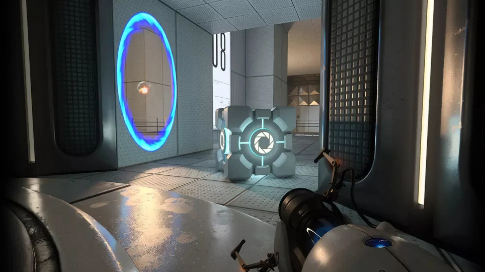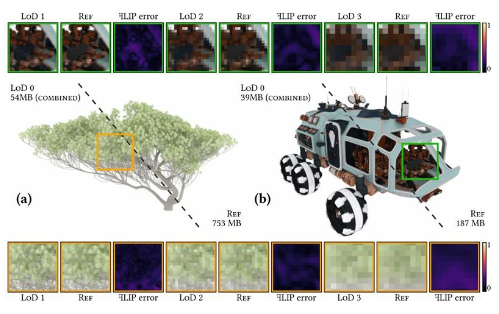 Technology peripherals
Technology peripherals
 It Industry
It Industry
 Intel Ray Tracing Technology Research: New Progress in Efficient Path Tracing Rendering
Intel Ray Tracing Technology Research: New Progress in Efficient Path Tracing Rendering
Intel Ray Tracing Technology Research: New Progress in Efficient Path Tracing Rendering
Recently, Intel engineers have made compelling new developments in the areas of tracing ray paths and exploring neurographics research. They are working hard to improve the efficiency of path tracking to achieve integrated GPU real-time path tracking. This series of research results were introduced through three papers published at top international conferences such as SIGGRAPH, EGSR and HPG, and proposed a new path tracing optimization method, aiming to reduce the number of calculations for simulating light reflection, thereby reducing the burden and improving GPU performance.

The chief engineer came up with an innovative method for calculating the effect of light when reflected using the GGX microsurface model. GGX is a graphics technology that can simulate the reflection of light in different directions. By simplifying the material into a hemispherical mirror, the new method simplifies the simulation process and increases computational efficiency.
Secondly, they also demonstrate a more efficient way to solve the challenging glitter surface rendering problem in 3D environments. According to their research, the method can increase the efficiency of rendering by taking into account the number of flashes visible on each pixel, and only render the flashes visible to the eye, avoiding unnecessary calculations.

Finally, they introduced a new method called "Markov Chain Mixture Models for Real-Time Direct "Illumination" is a new method used to construct photo trajectories under different lighting scenarios. Although this method is more complex, it can achieve more efficient rendering technology and generate complex direct lighting effects in real time.
According to the editor Understand that although ray path tracing technology has been available in 2018, achieving high resolution and 60FPS real-time path tracing still requires powerful computing performance, and most GPUs are still unable to meet the needs of modern AAA games.

It is generally believed that if Intel can achieve excellent ray tracing performance on its integrated graphics cards, it will be expected to promote this technology to more mainstream products and improve the ray tracing effects of independent graphics cards. .This will provide users with a more realistic and immersive visual experience, bringing more significant progress to games and graphics applications.
The above is the detailed content of Intel Ray Tracing Technology Research: New Progress in Efficient Path Tracing Rendering. For more information, please follow other related articles on the PHP Chinese website!

Hot AI Tools

Undresser.AI Undress
AI-powered app for creating realistic nude photos

AI Clothes Remover
Online AI tool for removing clothes from photos.

Undress AI Tool
Undress images for free

Clothoff.io
AI clothes remover

AI Hentai Generator
Generate AI Hentai for free.

Hot Article

Hot Tools

Notepad++7.3.1
Easy-to-use and free code editor

SublimeText3 Chinese version
Chinese version, very easy to use

Zend Studio 13.0.1
Powerful PHP integrated development environment

Dreamweaver CS6
Visual web development tools

SublimeText3 Mac version
God-level code editing software (SublimeText3)

Hot Topics
 Intel Core Ultra 9 285K processor exposed: CineBench R23 multi-core running score is 18% higher than i9-14900K
Jul 25, 2024 pm 12:25 PM
Intel Core Ultra 9 285K processor exposed: CineBench R23 multi-core running score is 18% higher than i9-14900K
Jul 25, 2024 pm 12:25 PM
According to news from this website on July 25, the source Jaykihn posted a tweet on the X platform yesterday (July 24), sharing the running score data of the Intel Core Ultra9285K "ArrowLake-S" desktop processor. The results show that it is better than the Core 14900K 18% faster. This site quoted the content of the tweet. The source shared the running scores of the ES2 and QS versions of the Intel Core Ultra9285K processor and compared them with the Core i9-14900K processor. According to reports, the TD of ArrowLake-SQS when running workloads such as CinebenchR23, Geekbench5, SpeedoMeter, WebXPRT4 and CrossMark
 Intel N250 low-power processor exposed: 4 cores, 4 threads, 1.2 GHz frequency
Jun 03, 2024 am 10:26 AM
Intel N250 low-power processor exposed: 4 cores, 4 threads, 1.2 GHz frequency
Jun 03, 2024 am 10:26 AM
According to news from this site on May 16, the source @InstLatX64 recently tweeted that Intel is preparing to launch a new N250 "TwinLake" series of low-power processors to replace the N200 series "AlderLake-N" series. Source: videocardz The N200 series processors are popular in low-cost laptops, thin clients, embedded systems, self-service and point-of-sale terminals, NAS and consumer electronics. "TwinLake" is the code name of the new processor series, which is somewhat similar to the single-chip processor Dies using a ring bus (RingBus) layout, but with an E-core cluster to complete the computing power. The screenshots attached to this site are as follows: AlderLake-N
 Close-up of LGA-1851 socket, Guangji showcases new embedded motherboard: supports Intel Core Ultra 200 series processors
Apr 11, 2024 pm 09:22 PM
Close-up of LGA-1851 socket, Guangji showcases new embedded motherboard: supports Intel Core Ultra 200 series processors
Apr 11, 2024 pm 09:22 PM
According to the news from this site on April 11, according to the German technology media ComputeBase, Guangji Technology attended the EmbeddedWorld2024 conference and publicly demonstrated a motherboard using the LGA-1851 slot for the first time. This motherboard is compatible with Intel Meteor Lake processors and is mainly used in embedded systems. The media took an in-depth look and shared multiple photos, confirming that LGA-1851 is the same size as Intel’s existing LGA-1700 socket. The relevant pictures attached to this site are as follows: Not compatible with CPU, but compatible with CPU coolers but not LGA-1851 socket 151 additional pins were added and the CPU locking system was adjusted, so it is not compatible with existing LGA-1700 socket processors. But because LG
 Intel announces Wi-Fi 7 BE201 network card, supports CNVio3 interface
Jun 07, 2024 pm 03:34 PM
Intel announces Wi-Fi 7 BE201 network card, supports CNVio3 interface
Jun 07, 2024 pm 03:34 PM
According to news from this site on June 1, Intel updated the support document on May 27 and announced the product details of the Wi-Fi7 (802.11be) BE201 network card code-named "Fillmore Peak2". Source of the above picture: benchlife website Note: Unlike the existing BE200 and BE202 which use PCIe/USB interface, BE201 supports the latest CNVio3 interface. The main specifications of the BE201 network card are similar to those of the BE200. It supports 2x2TX/RX streams, supports 2.4GHz, 5GHz and 6GHz. The maximum network speed can reach 5Gbps, which is far lower than the maximum standard rate of 40Gbit/s. BE201 also supports Bluetooth 5.4 and Bluetooth LE.
 MSI launches new MS-C918 mini console with Intel Alder Lake-N N100 processor
Jul 03, 2024 am 11:33 AM
MSI launches new MS-C918 mini console with Intel Alder Lake-N N100 processor
Jul 03, 2024 am 11:33 AM
This website reported on July 3 that in order to meet the diversified needs of modern enterprises, MSIIPC, a subsidiary of MSI, has recently launched the MS-C918, an industrial mini host. No public price has been found yet. MS-C918 is positioned for enterprises that focus on cost-effectiveness, ease of use and portability. It is specially designed for non-critical environments and provides a 3-year service life guarantee. MS-C918 is a handheld industrial computer, using Intel AlderLake-NN100 processor, specially tailored for ultra-low power solutions. The main functions and features of MS-C918 attached to this site are as follows: Compact size: 80 mm x 80 mm x 36 mm, palm size, easy to operate and hidden behind the monitor. Display function: via 2 HDMI2.
 ASUS releases BIOS update for Z790 motherboards to alleviate instability issues with Intel's 13th/14th generation Core processors
Aug 09, 2024 am 12:47 AM
ASUS releases BIOS update for Z790 motherboards to alleviate instability issues with Intel's 13th/14th generation Core processors
Aug 09, 2024 am 12:47 AM
According to news from this website on August 8, MSI and ASUS today launched a beta version of BIOS containing the 0x129 microcode update for some Z790 motherboards in response to the instability issues in Intel Core 13th and 14th generation desktop processors. ASUS's first batch of motherboards to provide BIOS updates include: ROGMAXIMUSZ790HEROBetaBios2503ROGMAXIMUSZ790DARKHEROBetaBios1503ROGMAXIMUSZ790HEROBTFBetaBios1503ROGMAXIMUSZ790HEROEVA-02 joint version BetaBios2503ROGMAXIMUSZ790A
 Intel explains in detail the Intel 3 process: applying more EUV lithography, increasing the frequency of the same power consumption by up to 18%
Jun 19, 2024 pm 10:53 PM
Intel explains in detail the Intel 3 process: applying more EUV lithography, increasing the frequency of the same power consumption by up to 18%
Jun 19, 2024 pm 10:53 PM
According to news from this site on June 19, as part of the 2024 IEEEVLSI seminar activities, Intel recently introduced the technical details of the Intel3 process node on its official website. Intel's latest generation of FinFET transistor technology is Intel's latest generation of FinFET transistor technology. Compared with Intel4, it has added steps to use EUV. It will also be a node family that provides foundry services for a long time, including basic Intel3 and three variant nodes. Among them, Intel3-E natively supports 1.2V high voltage, which is suitable for the manufacturing of analog modules; while the future Intel3-PT will further improve the overall performance and support finer 9μm pitch TSV and hybrid bonding. Intel claims that as its
 Intel Panther Lake mobile processor specifications exposed: up to '4+8+4' 16-core CPU, 12 Xe3 core display
Jul 18, 2024 pm 04:43 PM
Intel Panther Lake mobile processor specifications exposed: up to '4+8+4' 16-core CPU, 12 Xe3 core display
Jul 18, 2024 pm 04:43 PM
According to news from this site on July 16, following the revelation of the specifications of the ArrowLake desktop processor and the BartlettLake desktop processor, blogger @jaykihn0 released the specifications of the mobile U and H versions of the Intel PantherLake processor in the early morning. The Panther Lake mobile processor is expected to be named the Core Ultra300 series and will be available in the following versions: PTL-U: 4P+0E+4LPE+4Xe, 15WPL1PTL-H: 4P+8E+4LPE+12Xe, 25WPL1PTL-H: 4P+8E+4LPE+ 4Xe, 25WPL1. The blogger also released the 12Xe nuclear display version of the PantherLake processor.





